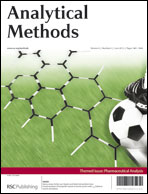Magnetic microbead-based enzyme immunoassay for ovalbumin using hydrodynamic voltammetry and fluorometric detection
Abstract
A paramagnetic microbead-based enzyme immunoassay was demonstrated for detecting ovalbumin (OVA). The immunoassay sandwich was made by attaching a biotinylated antibody to the streptavidin coated beads as a mobile solid phase, capturing


 Please wait while we load your content...
Please wait while we load your content...